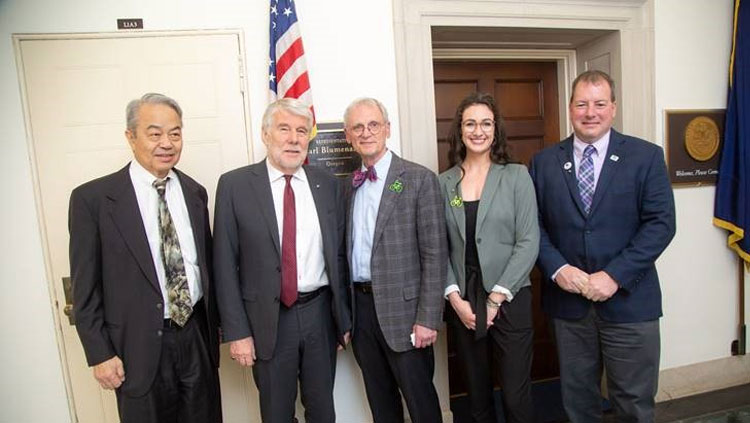Public Outreach – Essential for Communities and Researchers
One of the many consequences of the recent COVID-19 pandemic has been the disruption to Brain Awareness Week (BAW). Meant to bring together neuroscientists and the public every March, many BAW events were cancelled or postponed in the wake of the pandemic.
Avoiding in-person contact with the public, however, does not mean that scientists need to put their outreach on hold. On the contrary, a situation when public health is threatened makes it all the more important for scientists to build connections with their community.
Outreach is more than a benefit for the general public; it gives researchers skills to become better communicators. Here, SfN members show that outreach is not just a hobby, but a core part of being a scientist.
Reaching Out in Unprecedented Times

braiNY Brain Awareness Week Co-Chairs Heidi Meyer (left) and Ali Cohen (right)
Despite the limitations surrounding in-person events, scientists still have ways to connect with the public, primarily through online outreach. For example, the SfN New York chapter, braiNY, was able to organize a number of outreach events that accommodated their area’s restrictions on social gatherings.
“Outreach looks different during this time due to social distancing. However, those interested in educating or engaging with the community shouldn’t be discouraged from doing so,” said Heidi Meyer, postdoctoral fellow at Weill Cornell University and co-chair of braiNY’s Brain Awareness Week alongside Ali Cohen.
“Virtual outreach endeavors give us the unique opportunity to connect with people not just in our local community, but also our global community,” said Cohen, postdoc at New York University.
For example, the Biobus — a mobile lab with lessons aimed at pre-K through twelfth-grade students and organized in partnership with braiNY — began hosting virtual Student Town Halls on a range of science topics. The Neuroscience Outreach Group at NYU (NOGN) is featuring short videos recorded by NYU neuroscientists showcasing their work and presenting snapshots of their home life.
Although not a replacement for in-person interaction, many organizers have found that online events can be successful and extend their reach even further.
“We've been pleasantly surprised by how much moving our outreach activities to virtual platforms has actually helped us reach more people.”Carla Golden
Postdoctoral Researcher
New York University
“We've been pleasantly surprised by how much moving our outreach activities to virtual platforms has actually helped us reach more people,” said Carla Golden, an organizer for NOGN and March for Science NYC. Golden points out that since moving online, the March for Science happy hours have been able to bring in more viewers of all ages from across the country, including speakers that previously were unavailable.
For another example of an event that is at once successful, engaging, and safe, take “The Artistic Brain – A Neuroaesthetics Approach to Health, Well-Being, and Learning,” a webinar hosted March 19 by BrainFacts.org (see video above). During this webinar, International Arts + Mind Lab founder and executive director Susan Magsamen discussed the multiple ways that art changes our brains. Moderated by Kelley Remole, senior director of programs at Columbia’s Zuckerman Institute, the discussion drew a record 350 attendees, including researchers, educators, and students passionate about a fascinating new field.
Building Skills and Community
With many labs going remote-only and with the public seeking scientific voices more than ever, there is an opportunity for researchers to build communication skills across multiple platforms.
There are many ways researchers can practice these skills, including virtual journal clubs, meetings with other labs to break down a project for multiple audiences, and written summaries and video demonstrations accessible to the public. At the same time, initiatives like the new braiNY BAW 2020 blog offer a venue for bringing together the science community, as neuroscientists of all career stages and fields share their research, network, and stay in contact.
Social media can also be an important tool in finding an audience, as seen by the dozens of tweets from organizations and individuals during Brain Awareness Week. From at-home activities to research summaries and online events, the resources that the Dana Foundation and others shared show a path to celebrating brain science and providing important educational resources.
Regardless of the platform, one of the most important skills in outreach is listening to and understanding the audience. This is especially true during a crisis that affects the daily lives of scientists and non-scientists alike.
“By continuing to engage in outreach, we build trust in science, foster the belief that science benefits humankind, and provide reassurance and hope for the future.”Elizabeth Waters
braiNY chair of communications
associate director of STEM outreach
Cooper Union
“The effect of COVID-19 is going to persist beyond the self-isolation phase that we are experiencing right now,” said Elizabeth Waters, braiNY communications manager and associate director of STEM outreach at The Cooper Union. “By continuing to engage in outreach, we build trust in science, foster the belief that science benefits humankind, and provide reassurance and hope for the future.”
Getting Involved
Given new restrictions on in-person interaction, outreach can seem like a daunting task, especially for early career scientists. Thankfully, there is a host of resources, including from SfN, available for new organizers.
“You don’t need to build programs from scratch yourself,” said Heather McKellar, executive director of the Neuroscience Institute at New York University Langone Health. “We have been very successful in building NOGN by partnering with groups that already exist, such as a summer science program for high school students or after school programs in school. You can be the brain expert!”
In addition to outside partnerships, institutions often have outreach initiatives already in place and can be a great place for researchers to get started.
“Most institutions have outreach groups with a number of excellent resources to help new volunteers,” said Cohen. “But if you don't have such a group at your institution — as was the case when I was in grad school — reach out to another group in the area and, in my experience, they'll be happy to work with you.”
Successful outreach is built on communication — with researchers, with other organizations, and with the public. By building communication skills, organizers not only bring the public and researchers closer together, they become more capable researchers themselves.























